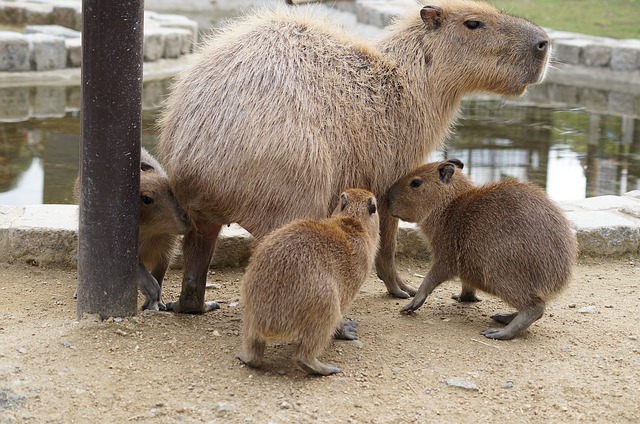General info for capys in captivity:
Capybara babies need to stay with their mother for at least seven days. They require a need a clean warm area for sleeping. A heat lamp works just fine.
They need replacement milk. They will suck a bottle or will drink from a dish. A good idea is to place a hand full of a good puppy chow on top of the milk to make sure they get the proper essential vitamins for growth. Chopped vegetables and fruit is a real treat. They love corn on the cob, Capybaras are docile animals. They prefer to initiate their affections. Yes, they can and will bite. Little is a big fat little pig, weighing in at 250 pounds plus. She loves being petted and rubbed down. She loves to be sprinkled with the water hose and would get in your lap.

Capybaras interacting with different animals
Being very family orientated, capys bond with other animals and people. Little was raised with a dog and yes she thinks she is a dog. She barks in her native tongue. Capybaras have a barking sound in the wild as a form of communication of warning of dangers.
Males or females make good pets. Pets respond to their surroundings and care. Neither have an odor if kept clean. Male pets do not get aggressive. Here you can read more about capybara with other animals.
Questions often asked about capybaras:
Can capybara be litter box trained? We use only the water pan as a source for bath room use. We do not keep them in the house. They have to have water available for their skin. They tend to have a dry fungus looking condition if they are deprived of water. This condition can be deadly. The skin will peel off their bodies.
Capybaras as a house pet? Capybaras have large teeth that need to be grinded, chewing is a natural instinct for them. Their teeth will grow into their jaws and the roof of their mouth. They love to chew on rugs, paper and wood. That antique table leg might look inviting to them. Stop and think. A pig in the house for a short visit is nice and makes a nice conversation but not practical.
They will learn to use a dog door. Remember, capybaras are wild animals that have been taken from their natural environment for our pleasure. They are water hogs and they can be messy.
Lease training: They respond to the collars and harnesses. Collars work the best with the lease. They respond well with treats. They also respond to your whistles.
Bottle feeding: Capys will take a bottle of milk just like the other small animals. Remember the teeth that they have when they are born. Capybaras do not need to be bottle fed to be a pet or pest. Little was not a bottle baby.
Digging: Capys do not dig or root the ground like pigs. They will go under, over or through any opening they find. They are natural fence walkers.
In families of capys there is always a dominate male. They will spar with each other and bite and run the lesser away. The real aggression comes when one steals the babies. Every capy in hearing distance will be to the rescue and they are very fast runners.
Capybara babies can run and dart just like a little pig and squeal as loud. Netting is the safer source in capturing the little ones. It is safer for you and the babies.
Capybara adapt to the climates and elements. In captivity care should be given to their need of heat, shade, and areas for birthing. All ages spend most of the day basting in the sun and sleeping. Night time is spent roaming the area and eating.
Capys are excellent swimmers. They are equipped with special nostrils to emerge in the water for long periods.
Reproduction: Capys are considered adults as early as eighteen months of age. Gestation period is one hundred and fifty days. Normal is two to four births. It is impossible to look at a baby capy and determine the sex. They have to be vent sexed as babies. The males will acquire a large scent gland on the top of their noses as adults. It is called a “morrillo”.
Are capybaras consumed for meat? In South America the capybara is considered a source of food for many people. Before you gag remember that they are called “water hogs” not rats. The meat of the capybara is white and taste and looks like pork.
*In Brazil Indians raise capybaras for the meat. The capybara is main source of food for Guato Indian Tribe.
The size of the capybara (125 to 175 pounds) with the tasty meat, valuable leather, medicinal use of the fat and their high reproduction rate makes the capybara a candidate for ranching and intense husbandry.
